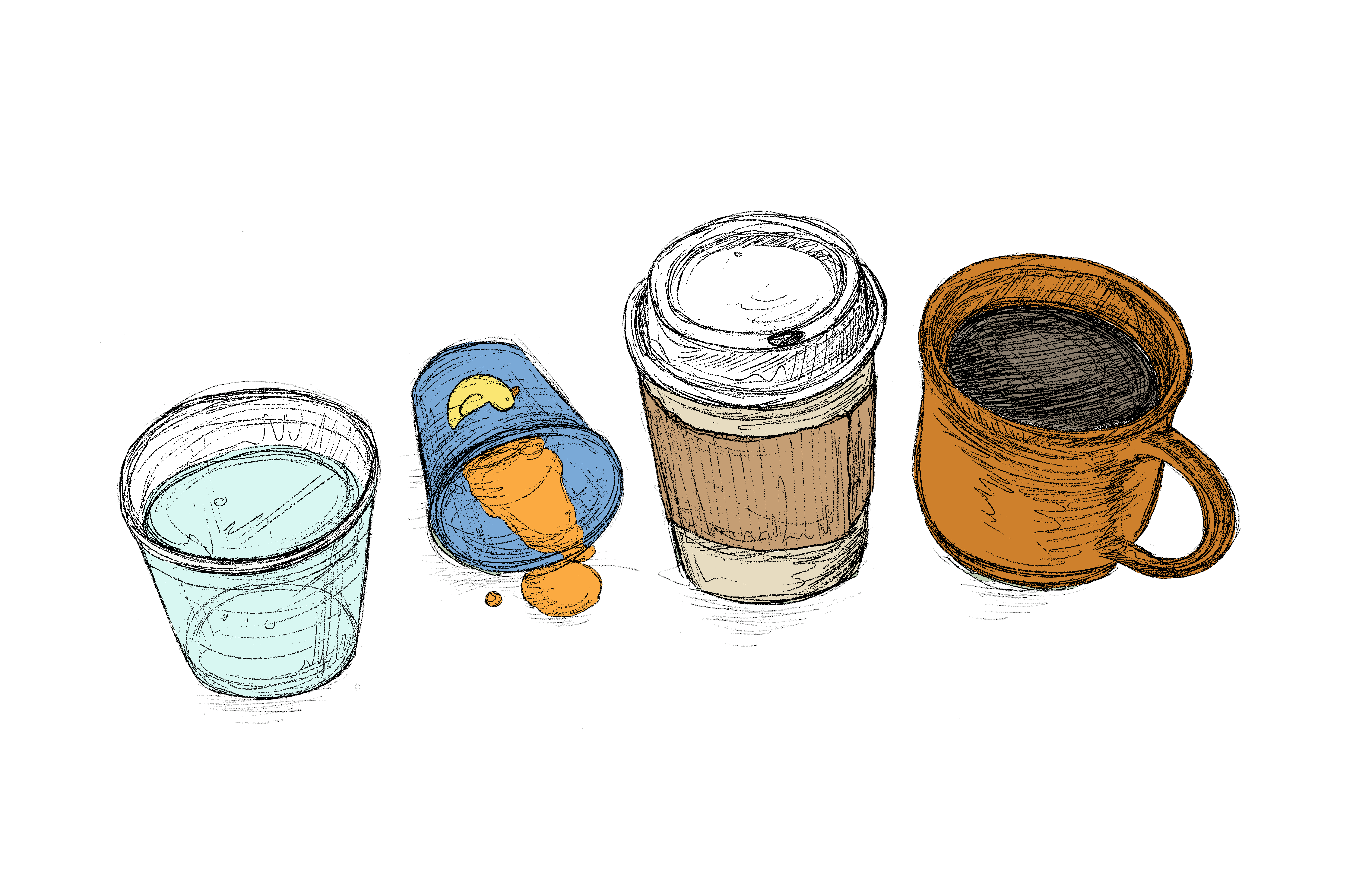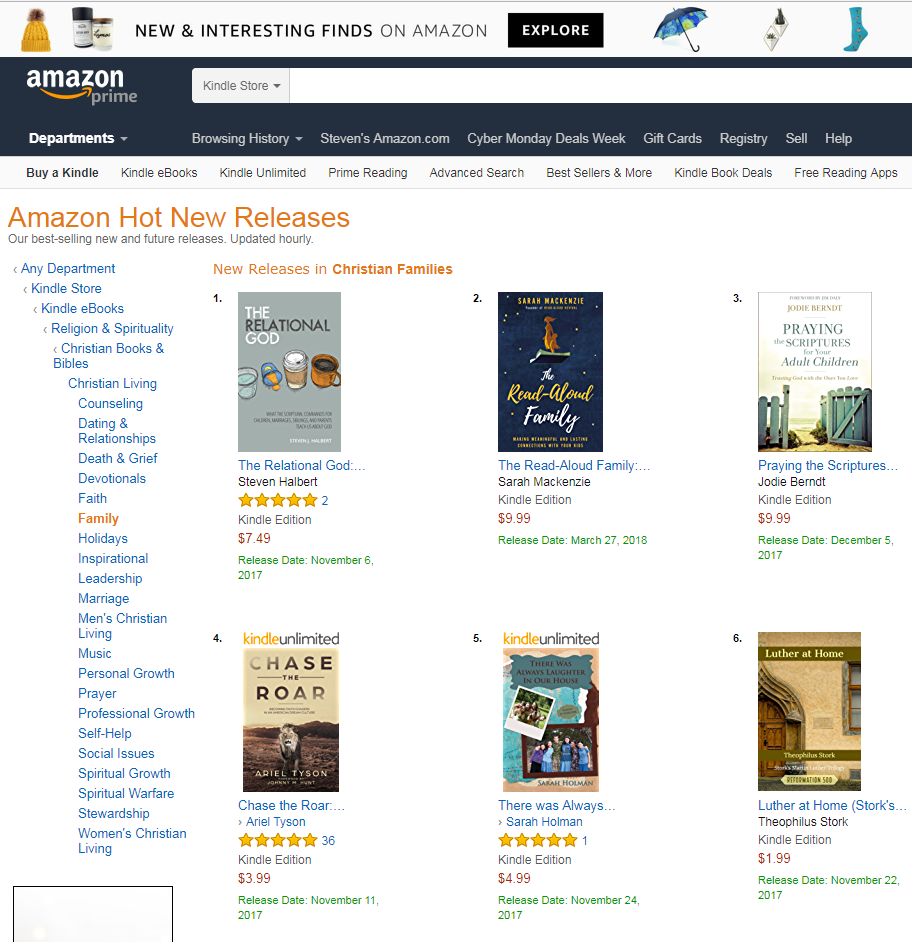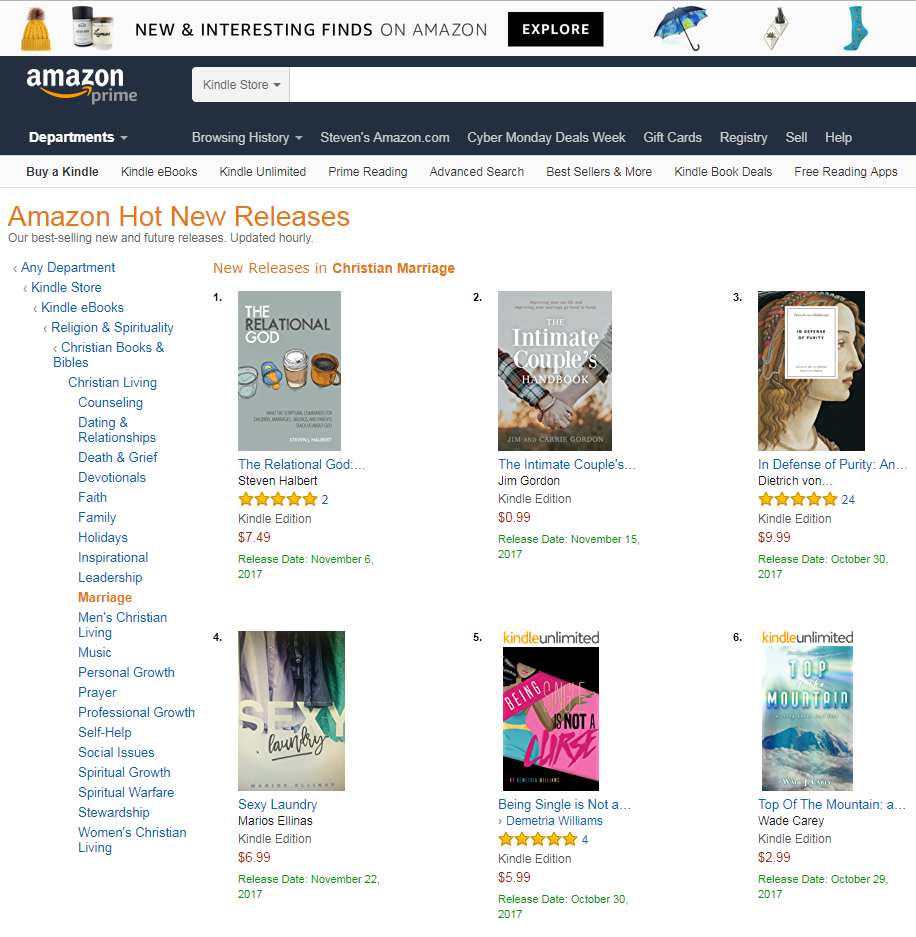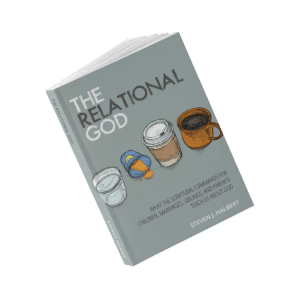Introduction
Writing and publishing a book has consumed the last two years of my life. Last weekend I started to pack up the remnants of that project. The book (and writing in general) will always define a small part of my life. If nothing else, this experience has given me a “hobby” and an outlet of sorts (writing/blogging), but this first book took a lot out of me.
I wrote a blog post about the “back story” of the book just before it was published (see The Relational God Back Story: Part I). At the end of that blog, I promised a sort of Paul Harvey “the rest of the story.” Well, now, nearly one year later, here it is. It is rather fitting that it be published today, as today is the one year anniversary of the KickStarter ending (see below). As I begin to wind down this project, I think this post is more therapeutic than anything else.
Executive Summary
I had been thinking about this book for over 5 years. The book (and the “small business” behind it) cost about $8,500 and countless hours of my time. For the two months prior to publication, I was putting in about 40 to 60 hours per week on the project (in addition to my current job). Since publication, I have been through two additional edits, and the book is now probably where it would have been quality-wise if I had gone through a traditional publisher (this is also included in the $8,500 number).
If I were to extricate the costs solely associated with publishing a book for the first time, it would have cost about $3,800. Knowing what I know now (i.e. based on everything I learned through this process), I could probably produce a high quality book for right around $1,500 (including editing). If I was content not having it edited, I could probably produce a book for around $500.
A lot of the additional expense was due to rushing (two months is aggressive even for a traditional publishing house; so trying to get editors, designers, eBook creators, etc. on the spur of the moment added to the cost) and the quest for perfection (i.e. the day before publication I made a change and I wanted to see the product before it went “live” . . . this cost me $150 . . . I would never do that now). These two things were due, primarily, to inexperience.
Timeline Details for Publishing
Below is a timeline of how this book came to be, and a few of the obstacles along the way. If you’re considering publishing a book, I’d be happy to go into more detail with you, just reach out:
Pre-2016:
The earliest saved draft of the book on my computer is from April 2014. The ideas for this book had been rattling around in my head for a while (I actually have a journal entry from April 2013 with a very basic outline). But in April 2014, I actually started trying to write something.
September 2016:
After a few repeated attempts to draft this book, I finally asked our Sunday school class if I could teach through the concepts. Teaching proved to be the catalyst necessary for creating the book, because it forced me to create a structure and outline for the concepts that eventually became the book.
April through July 2017
The book has 4 distinct sections. By April 2017, I was most of the way through Section 1, and the other sections were beginning to take shape as I taught them on Sunday morning. A friend sent me a link to a 21-session course on how to get published by Michael Hyatt. It had a money back guarantee, so I figured, why not? It was really helpful. I listened to most of it in April. Then I spent May, June, and July trying to write a book proposal and secure an agent. If anyone is trying to break into this industry, I would strongly recommend it. It is a good starting point. You can find out more here: https://getpublishedcourse.com/.
August 2017
August was a pivotal month for the book. After failing multiple attempts to secure an agent, I was feeling pretty discouraged. Mostly, because the agents were all saying roughly the same thing. The book was good, but I just didn’t have a “platform.”
Due to the radical changes in the publishing industry over the past few years (see below for information on POD), if you can’t bring 3,000 – 5,000 readers to the table, publishers won’t really consider you. In early August, we went to the beach, and I spent several afternoons writing and looking into self-publishing. Towards the end of the month, we were eating dinner with some friends. One of those friends is the Director of Marketing at a large corporation.
Over dinner, a plan for self-publishing and gaining an audience began to form. I estimated that I needed about $5,000 to do a really solid job of publishing, so we decided to start a KickStarter campaign with the hopes of getting 1,000 to 2,000 people to pledge at the $2 level. That would gain me a “platform” as well as provide a budget.
September through November 2017
The Kickstarter for Self-Publishing
- Our family moved in July, and my wife generously agreed to let me have about $1,300 of our equity for this book project. I spent most of that in August and September getting set up for basic publishing (business license, basic design work, ISBNs, proofs/printing costs, etc.) and starting to advertise the KickStarter campaign through Facebook and various social media platforms. KickStarter is an all or nothing fundraising tool. If you don’t meet your goal, you don’t get any of the money.
- The KickStarter began on 9/4/2018, and it did not go as planned. I can’t begin to describe the sort of stress that brought into my life. I was spending time and energy on the KickStarter campaign instead of on the book project, and I was not getting the small donations I had hoped for (even with targeted Facebook ads). Friends and family were giving, but not enough to raise the necessary $5,000. I stalled out at about $2,000.
- On 9/25/2018, someone logged in to KickStarter and finished it with a gift over $2,000. When I saw that, I nearly broke down and cried. I had just prayed that very morning about what I was going to do if I didn’t raise the money, and I felt like God was saying, “don’t worry about it.” Later that night, it was finished. The family who gave the money later told me that the Lord woke them up early that morning (while I was praying) and laid it on their heart to give, but, since their wallets were in their car, they didn’t actually do it until that night. The KickStarter officially ended on 10/10/2017, but the final gift really took a huge burden off my shoulders. You can actually still view the project and watch the promo video here: https://www.kickstarter.com/projects/952578099/the-relational-god
From Kickstarter Completion to Self-Publishing
- Once I knew the KickStarter had been funded, I toyed with the idea of going through a self-publishing company like Westbow Press. I spoke with them a few times, but ultimately I would not have owned my own website, I could not have set my own pricing, and I would not have had nearly as much control over my book. Based on the work that I did, Westbow Press would have been about $4,000 (Online Platform Package), but would not have included any editing or the production of an audio book (both of which my book has).
- I had a deadline of November 7th 2018, and I was determined to hit it. These months are a bit of a blur. I spent hours writing, reading/editing (when September started, I had not decided whether I was going to spend money on a professional editor), and essentially running the small business of a publishing company. But I made my deadline.
- On November 7th 2018, the book was available in hardcover, paperback, and eBook (both for Kindle and the rest of the world) formats. It was available online and by order through various stores (Barnes & Noble, Lifeway, etc.).
Publishing Print on Demand (POD) and eBooks
- The above was no small task. Figuring out printing and distribution was tricky; however, it really made me understand what the agents had been talking about. These books use what’s called “Print on Demand” (POD) technology. In other words, they don’t exist until you order them. I did not have to buy inventory, and Amazon is still able to honor Prime shipping with this technology. They print them, bind them, and ship them within two days. Amazing! This is ultimately why, if you can’t bring 3,000 to 5,000 readers to the table, publishing companies won’t really look at you. Those numbers represent a minimum print run. Printing that amount of copies through a traditional printer gives you the economies of scale to get your costs lower than what the POD technology can offer. The POD technology is impressive, but its costing structure is the same whether you buy one copy or 20,000 copies.
- For those of you interested in how the mechanics of POD works for hardcover and paperback, I’d be happy to have a conversation with you. There are two primary players in the paperback world – IngramSpark (https://www.ingramspark.com/) and Amazon KDP (https://kdp.amazon.com/en_US/). IngramSpark is currently the only major player in the hardcover POD world (additionally, IngramSpark is really the only major player if the interior of your book contains color).
- Also, if you’re curious about eBook production, this is the one thing that I outsourced completely. I gave someone my specifications (because I wanted a number of pretty advanced things like tables, clickable links for the Bible verses, etc.), and that person gave me two files (an .epub and a .mobi). ePub is what most of the world uses, and mobi is what Kindle uses. There are computer programs that will essentially grind out these files for you, but, as I said, I was looking for something very specific. A helpful website for getting started is Smashwords (https://www.smashwords.com/about/how_to_publish_on_smashwords). Smashwords has a few of those programs and also a list of contacts who can do the conversion for you. Smashwords will also distribute your eBook to several important markets.
Final Tasks for Publishing
- Additionally, I sent several “advance copies” and Marketing Kits to various like-minded ministries, offering to partner with them if they would send the book out to their contacts or on their social media page, I would donate the proceeds from the sales. Only a couple ministries took me up on it.
- I read the book at least 5 or 6 times during this period, and I was pretty proud of the result. After publishing, I also did a marketing blitz during Black Friday, and my book made it to number one in New Releases for Christian Marriage and Christian Family (it also made it to number 3 overall in the Christian Marriage category – right up there with 7 Love Languages, Love and Respect, etc.).
December 2017
Our family gave a collective sigh of relief that the book project was “finished.” My dad had been wanting to read audio books on the side, so he did the audio book as our Christmas present.
The way audio books are done is pretty cool. The back-end of Audible has some pretty advanced instructions for what is required, but you can actually put your book out for bid and either split royalties with a reader or pay a reader outright. Once you have the file, though, you can distribute the audio book through other venues (provided you don’t sign up for exclusivity with Audible). So, while my dad did it as a gift, I would have no qualms splitting royalties with a reader in order to get a pretty professionally done audio book.
If you want to do it yourself, I’d estimate you need about $300 to $500 in equipment (audio mixer, professional microphone, etc.). Once you purchase once, you should be good to go (and you could read other people’s books). The rough standard is about 3 to 4 hours of work for every 1 hour of finished product (so my book is about 7.5 hours, which means about 20 to 30 hours of work to produce the audio book). Since it was my dad’s first time, it took about 50 to 60 hours, but he did an excellent job.
2018 (post-Publishing)
January and February 2018
I made a pretty extensive edit based on feedback from various readers (as well as reading through it again myself).
March through April 2018
I began work on the Bible study. This time I was determined not to put in quite so many hours just to get it done. I sent some early chapters out for feedback and met with various early readers. I have a good direction now, but I am still working on it (October 2018). I’m targeting a March/April 2019 release date.
May through August 2018
I decided to enter a prominent contest. This was a sort of last-ditch effort to gain some exposure for the book and increase traction and sales. The deadline for entry was August, so I read the book one more time and then sent it to another editor. The editor made her edits, and I implemented the changes. I read the book one final time (which is always smart after making extensive changes), and I uploaded the revised copy to my various distributors. It occurred to me that this is likely what a book published by an established publisher would have gone through before it’s initial publication. Additionally, I converted all my cover artwork to a Microsoft program and began learning how to design a solid, quality cover. (Since I wanted to make some changes to the cover without paying a designer, but was mostly out of money.)
August through September 2018:
I entered the book into the contest and found out late September that I had not won the contest. I thought about entering into another contest, but, as I prayed and read God’s Word, I felt Him leading me toward the word contentment. The book is done. God can use it how He wants to use it. In the crazy, media saturated world we live in, this book could become a best-seller tomorrow or it could sink into obscurity. Either is fine. It’s all His anyway. I have created something with excellence, and it honors God. As I say in the final Acknowledgment in the book: soli Deo Gloria!
Monetary Details for Publishing
At the time of this writing, this book has made it into the hands of 155 people. As every good accountant knows, if you want to understand the story, follow the money. For those of you seriously contemplating writing a book (or just curious about the money), take a look at the outline below. If this discourages you, be sure to catch my statements at the very bottom.
April 2017 ($300)
- Listened to Michael Hyatt’s course on getting published
- Wrote a Book Proposal
- The Money
- ~$300 on the publishing course
- Running Total: $300
May 2017 through July 2017
Sent proposals to several literary agents (~2x at a time) and waited for replies. All rejections stated the I just didn’t have the “platform” to make the book worth a publisher’s time.
August 2017 ($690)
- Vacation – began writing in earnest and researching self-publishing
- Supper with Friends – self-publishing plan and KickStarter campaign takes shape.
- The Money
- ISBNs (~$300)
- Business Reg. (~$50)
- Website/email ($~90)
- Design – Tusitala Publishers logo and mugs for the cover (~$150)
- Marketing (~$5)
- Proofs/Printing – quality of POD and hard copy of book for edit (~$50)
- Meals and Networking – meeting with folks who could help (~$45)
- Running Total (August: $690 / Total: $990)
September 2017 ($605)
- KickStarter launched on 9/4/2018
- KickStarter funded on 9/25/2018
- Reading/editing, plugging the KickStarter, working on cover/website, etc.
- The Money
- Website/email – domains, addresses, etc. (~$100)
- Design – website and cover (~$300)
- Design – font (~$15)
- Advertising – mostly Facebook ads for the KickStarter (~$80)
- Proofs/Printing – hard copies for editing and ministries (~$65)
- Shipping – ministries – SFLA, CIU, Authentic Manhood, etc. (~$35)
- Meals and Networking – meeting with folks who could help (~$10)
- Running Total (September: $605 / Total: $1,595)
October 2017 ($2,920)
- Reading/editing (finished draft 6), working with editor, design, etc.
- The Money
- Editing (~$1,335)
- Typesetting/Book Layout – ultimately did myself (~$350)
- eBook Conversion (~$750)
- Copyright (~$35)
- PO Box (~$200)
- Audio Book Recording Equipment (~$105)
- Advertising – again mostly Facebook ads this time about the book (~$60)
- Proofs/Printing (~$40)
- Shipping – ministries – Bethany and Village Church (~$30)
- Meals and Networking – meeting with folks who could help (~$15)
- Running Total (October: $2,920 / $4,515)
November 2017 ($2,645)
- Published, supporter fulfillment, advertising
- The Money
- Prints – for the Kickstarter supporters ($~300)
- Books – for the Kickstarter supporters ($~640)
- Tithe – for the money from Kickstarter (~$550)
- Shipping of items – for out-of-town donors and CT (~$70)
- eBook Purchase (~$20)
- Design – landing site and final cover (~$700)
- Marketing – business cards and book stubs (~$95)
- Advertising (~$40)
- Shipping – for final proofs (~$150)
- Shipping – Brother Al and CT (~$25)
- Meals and Networking – contest and supporter (~$55)
- Running Total (November: $2,645 / $7,160)
December 2017 ($260)
- Dad takes on the audio book and we post to Audible
- The Money
- Audiobook Equipment ($5)
- Website/email (~$50)
- Design – website and cover – changes and audio book (~$175)
- Advertising (~$5)
- Meals and Networking (~$25)
- Running Total (December: $260 / $7,420)
January 2018 ($5)
- The Money
- Advertising (~$5)
- Running Total (January: $5 / $7,425)
February 2018 ($90)
- The Money
- eBook Conversion – after edit (~$50)
- Proofs/Printing – for endorsement (~$35)
- Shipping (~$5)
- Running Total (February: $90 / $7,515)
March 2018 ($30)
- The Money
- Copyright – selected the wrong box previously (~$20)
- Shipping – for endorsement (~$10)
- Running Total (March: $30 / $7,545)
June ($150)
- The Money
- Editing (~$150)
- Running Total (May: $150 / $7,695)
July ($235)
- The Money
- Contest Entry (~$105)
- Books for Contest (~$60)
- Proofs/Printing (~$70)
- Running Total (July: $235 / $7,930)
August ($10)
- The Money
- Shipping – copy for editor (~$10)
- Running Total (August: $10 / $7,940)
September ($245)
- The Money
- Website/Email (~$150)
- Proofs/Printing (~$95)
- Running Total (September: $245 / $8,185)
Conclusion
The final eBook update is the last thing that needs to be done. As of the time of writing, I’m still waiting on this.
Budgetary Details for Publishing
If you look at this another way, many of the above months have elements of the following:
- Website/Email
- Design
- Marketing
- Advertising
- Proofs/Printing
- Shipping
- Meals and Networking
Much of that is not necessary for actually writing and publishing a book. If I took out all the items that have to do with setting up the business (including website and website design), running the KickStarter campaign, rushing some of the publishing steps, etc. I’m left with:
- ISBN’s (~$300)
- Design Work for Cover (~$750) – knowing what I know now, if I was doing this again, I could probably get away with a budget of $300 or less.
- Copyright (~$55)
- eBook (~$850) – again, knowing what I know now, I could probably get away with a budget of under $500.
- Editing (~$1,485) – I started this process wondering if I would even need an editor (I have an MA in English). This was probably the best investment in the whole project. Knowing what I know now, I would probably budget about $1,200 for this.
- Typesetting (~$350) – through this process, I actually ended up teaching myself this skill, so I would not budget for this again.
- Marketing (~$55) – I would actually probably up this budget a little bit.
Conclusion, Final Price, and Thanks
Based solely on the “Budgetary Details” above, my book cost about $3,845 to get published (first time). If I was doing it again, I think I could publish a book for well under $2,000. If I was content not to have it edited, I could probably do it for under $500. Overall, this was a fantastic learning experience. I don’t think I’ve ever worked so hard in my life, and I may not ever work that hard again. It was exhausting, but there is something quite satisfying about having a quality product with which you are happy.
That being said, some very kind and generous folks helped me get on my feet with this first book (as well as all the “extras” of having a business – website, business reg., etc.). I don’t intend to squander that. I just may move a little slower for the next set of publications. For now, blog posts will keep me going for a little while.
Signing Off: Steven J. Halbert
Take a look at the final product:
If you read my book, but didn’t leave a review, please do so on Amazon!
See more blog posts at:

If you know someone who might be interested in publishing through me, direct them to this website:




